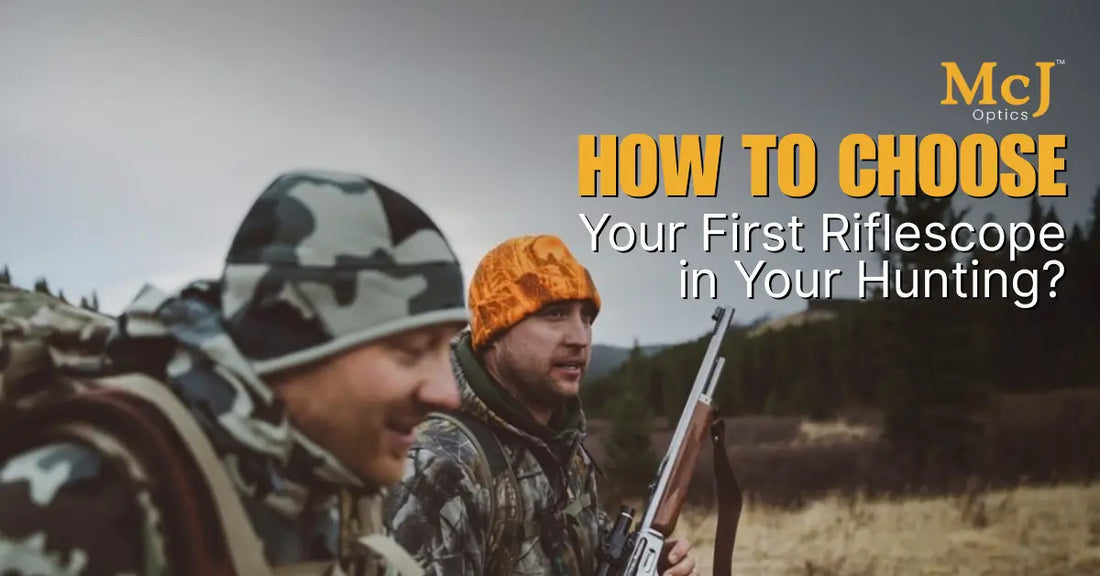
How to Choose Your First Riflescope for Hunting | McJOptics Guide
Share
How to Choose Your First Riflescope for Hunting

Stepping into the world of optics can feel overwhelming. With dozens of riflescopes on the market, how do you know what features matter most? This guide will walk you through what to look for when choosing your first riflescope—so your money works, your aim stays true, and your hunting confidence grows.
1. Start with the Hunting Context
Before choosing any scope, think about where you'll hunt and your typical shot distances. Will you stalk in dense woods, take shots across open plains, or a mix of both? Your environment helps guide the right magnification range, reticle style, and optical quality. Leupold explains: optics designed for dense versus open terrain will prioritize different specs (light-gathering, zoom range, clarity).
2. Magnification & Zoom Range
This is often the first specification buyers choose. A fixed-power (e.g. 4×) scope offers simplicity and durability. A variable zoom (e.g. 3–9×, 4–12×) gives flexibility. For a first scope, many hunters opt for 3–9× or 4–12×, giving room for mid-range flexibility without overcomplicating things.
Keep in mind:
- Lower magnification = wider field of view, faster target acquisition at close ranges
- Higher magnification = greater reach but also more shake, narrower view, and darker image in low light
3. Objective Lens & Light Transmission
The objective lens (front lens) size impacts how much light enters the scope. A 40mm or 42mm lens often offers a balanced mix of brightness and weight for many hunting needs. Too large, and your scope gets heavy; too small, and you lose brightness in dawn/dusk light. Good lenses with multi-coatings help maximize clarity even with more modest lens sizes.
4. Reticle Type & Focal Plane
Reticles come in many shapes and styles. Some include bullet drop compensation (BDC), mil-dot hash marks, or illuminated features. One major consideration is whether the reticle is first focal plane (FFP) or second focal plane (SFP):
- FFP: Reticle scales with magnification, so holdovers/hashes stay accurate across zoom. Preferred for precision and ballistic use.
- SFP: Reticle stays constant size, which often remains clearer at lower magnifications. Many hunters prefer SFP on their first scope for simplicity.
Vortex emphasizes that for a first riflescope, you don’t need extreme sophistication—a solid reticle with clear hash marks and good optics will serve most hunters well.
5. Durability, Sealing & Warranty
Your scope must endure recoil, temperature swings, moisture, dust, and rough handling. Look for specs such as waterproofing, fog-proofing, nitrogen or argon purging, and shock resistance. A lifetime or transferable warranty adds peace of mind—knowing the brand backs its optics matters as you grow in your shooting journey.
6. Eye Relief & Field of View
Eye relief is the distance your eye can stay behind the scope and still see the full image. Especially with heavier recoiling rifles, generous eye relief is vital to prevent “scope bite” (getting hit by recoil). Similarly, a wide field of view helps you track moving targets and re-acquire quickly after recoil.
7. Budget & Value Balance
Budget shapes what you can realistically get. A common mistake is overspending on features you might not fully use initially. Instead, allocate enough for good glass, reliable mechanicals, and a trusted brand. As your experience grows, you can upgrade—but starting with a dependable, well-matched riflescope gives you solid performance from day one.
8. Try Before You Buy (if possible)
Whenever possible, test optics in real settings—or shoot friends’ scopes. Sometimes the “feel,” brightness, and reticle comfort only reveal themselves when you look through it. As one long-range forum user put it: “You won’t know what features you prefer until you shoot with it.”

Putting It All Together: A Sample Setup
For many first-time hunters, a **3–9×42 SFP scope with a duplex or mild BDC reticle, good coatings, reliable sealing, and a solid warranty** strikes the right balance. As your shooting progresses, you may move into FFP, higher zoom, or more premium features—but this base will serve you reliably for many seasons.
Trust MCJ Optics for Your First Scope
At **MCJ Optics**, we aim to equip new and seasoned hunters with optics that match their mission—not just flashy specs. Our scopes combine clarity, durability, practical features, and support. As you begin your optics journey, we’re here to guide you and back your gear for years to come.
Ready to explore your first hunting riflescope? Visit our collection of hunting optics and find a model built for your terrain, game, and style.
